 Weird Stuff
Weird Stuff  Weird Stuff
Weird Stuff  Mysteries
Mysteries 10 Tragic Disappearances and Deaths in Joshua Tree National Park
 History
History 10 Ways Childhood Really Sucked in the Old West
 Music
Music 10 Name Origins of Famous Bands from the 1990s
 Religion
Religion 10 Biggest Turnarounds by the Catholic Church
 Weird Stuff
Weird Stuff 10 Unbelievable Times Laws Had Unintended Consequences
 Humans
Humans Ten Historic Women Who Deserve Way More Credit Than They Got
 Movies and TV
Movies and TV 10 Films That Spawned Major Lawsuits
 History
History Ten Times Towns Were Wiped Off the Face of the Earth
 Creepy
Creepy 10 of the Most Disturbingly Haunted Public Houses in the UK
 Weird Stuff
Weird Stuff 10 Niche Subcultures That Are More Popular Than You Might Think
 Mysteries
Mysteries 10 Tragic Disappearances and Deaths in Joshua Tree National Park
 History
History 10 Ways Childhood Really Sucked in the Old West
Who's Behind Listverse?

Jamie Frater
Head Editor
Jamie founded Listverse due to an insatiable desire to share fascinating, obscure, and bizarre facts. He has been a guest speaker on numerous national radio and television stations and is a five time published author.
More About Us Music
Music 10 Name Origins of Famous Bands from the 1990s
 Religion
Religion 10 Biggest Turnarounds by the Catholic Church
 Weird Stuff
Weird Stuff 10 Unbelievable Times Laws Had Unintended Consequences
 Humans
Humans Ten Historic Women Who Deserve Way More Credit Than They Got
 Movies and TV
Movies and TV 10 Films That Spawned Major Lawsuits
 History
History Ten Times Towns Were Wiped Off the Face of the Earth
 Creepy
Creepy 10 of the Most Disturbingly Haunted Public Houses in the UK
10 Incredible Astronomical Instruments That Existed Before Galileo
We’ve always had an undeniable fascination with the Sun, the Moon, and the night sky. While astronomy made massive leaps forward with the likes of Galileo and Copernicus, other astronomers had already spent thousands of years trying to learn all they could about the movement of the stars and the planets. Some of their ancient tools were so complex that it took us years to understand them.
10 Warren Field Calendar
Although the Warren Field calendar was actually discovered from the air in 1976, it was only unearthed by the National Trust for Scotland in 2004. Even so, it took us almost another decade to determine that it was something absolutely epic—“the beginnings of recorded time,” as an archaeological team from the University of Birmingham called it.
The calendar was a series of 12 pits spread out over an arc 54 meters (180 ft) long. Each pit was synced with a lunar month, but there were also corrections for lunar cycles. A straight lunar calendar wouldn’t have worked because there aren’t a set number of lunar cycles in a natural year. Amazingly, the pit system in Warren Field corrected for this 6,000 years before Stonehenge was built.
When the pits were excavated, it was found that the holes at the beginning and the end were the smallest. Although most of the pits were filled only with rocks and burned material, the fifth and sixth pits appeared to have held posts at one time. Those two pits were also misaligned with the others. After looking at everything around the arc, the archaeologists realized that the placement of the lunar calendar had a built-in reset. When the pit system was constructed, it lay at a point where the sunrise on the winter solstice would occur precisely at a break in the mountains now called “Slug Road Pass.” By using that moment as the starting point, the ancients were able to reset their lunar clock and keep on track.
This was all done around 8000 BC, making the pit system about 5,000 years older than some of the calendars we’ve found in the Middle East. Although we’d expect such a feat to be associated with an agricultural society, the civilization that built this ancient lunar calendar was one of hunter-gatherers. It’s possible that they used it to keep track of the movement of animals they needed for survival.
9 Al-Khujandi’s Mural Sextant
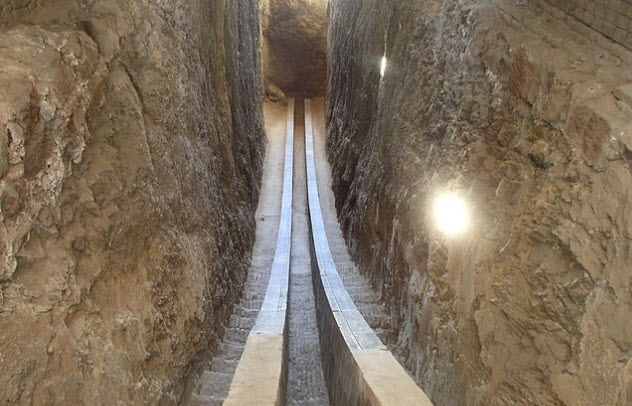
Not much is known about Abu Mahmud Hamid ibn al-Khidr al-Khujandi, except that he was a mathematician and astronomer living in the area that’s now Afghanistan, Turkmenistan, and Uzbekistan. However, we do know that he was responsible for building one of the largest astronomical instruments of the era—the mural sextant near Rayy. The mural was done on a 60-degree arc between two interior walls of a building. Measuring about 43 meters (140 ft) in diameter, the arc was sliced into degrees. Each degree was then divided into 360 parts, making the mural not only an incredibly precise solar calendar but also the first device capable of accurate measurement on such a small scale.
Between the summer and winter solstices, the Sun moves 47 degrees in the sky. Al-Khujandi’s arc room was topped with a domed ceiling that had a hole to allow the Sun’s rays to strike the arc. His calculations then allowed him to trace the movement of the Sun and to determine his latitude. Although the building settled during his experiments and slightly displaced the center of the arc, al-Khujandi’s pioneering work led to the development of other instruments like the astrolabe.
There were also other attempts to construct the massive arc. Observatories in the 13th and 15th centuries were much more successful at building accurate mural sextants because newer construction methods eliminated the problem of movement after the sextant was built.
8 The Volvelle And The Zodiac Man
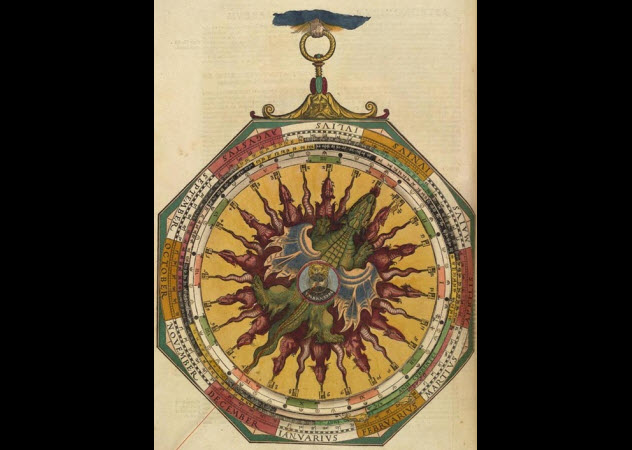
Brought to Europe at the turn of the 14th century, the volvelle was a weird sort of astronomical instrument that remained one of the key tools for scientists and physicians. Layered circles of parchment were held together by a single tie in the center that allowed the user to move all of the circles to calculate everything from the Moon’s phases and the Sun’s position to the zodiac. Other versions were made, too, including one that told the time of night based on the position of the stars.
Today, we might think that it’s just a clever, archaic, little gadget. At the time, though, it was a huge status symbol. Printed on parchment, only the richest of the rich could afford their own copies of the volvelle. However, at the beginning, some didn’t want volvelles. When the device was first brought to Europe by the philosopher Ramon Llull, many people thought that it was some kind of dark magic whose users could access an insidious, evil power. That fear gradually disappeared, and the volvelle made its way into the doctor’s handbag.
One of the most basic views of medieval medicine was that the human body was a microcosm, our vast universe on a small scale. With the belief that each one of the body’s parts and systems was governed by a particular planet, early medical texts almost always included a copy of the “Zodiac Man.” We still hear some references to it today. That’s why Aries is said to govern the head and Scorpio, the genitals.
To interpret the Zodiac Man, doctors needed a handy way to keep track of the Moon’s position, so they also carried volvelles. In theory, the Zodiac Man could also be used to determine the best time to take medicine and perform surgery, all based on the interactions of the stars. Unfortunately, volvelles were rather fragile, and few still survive.
7 Ancient Sundials

Sundials have been reduced to little more than kitschy garden accessories today. But at one time, they were necessary for telling time and tracking the movement of the Sun across the sky.
One of the oldest sundials was found in the Valley of the Kings in Egypt. Dated to between 1550 BC and 1070 BC, this sundial is a piece of limestone with a semicircle drawn on it. The semicircle is then divided into 12 sections. Strangely enough, this sundial was found with workmen’s drawings, suggesting that it was used to track work hours or to represent the Sun god’s movement through the night and the underworld.
Shortly after the discovery of the Egyptian sundial, another was found in Ukraine, buried with a man who had died between 3,200 and 3,300 years ago. Likely sacrificed as a messenger to the gods, he was buried with an “analemmatic sundial.” Different than a traditional sundial, an analemmatic sundial was read with a movable pillar called a “gnomon,” which was shifted every day to account for the movement of the Sun in the sky. The sundial also revealed that the Srubna people had geometric knowledge that allowed them to account for latitudes and the different angles of the Sun’s position as they moved north or south. The sundial found with the dead man was calibrated for that specific latitude.
6 Nebra Sky Disk
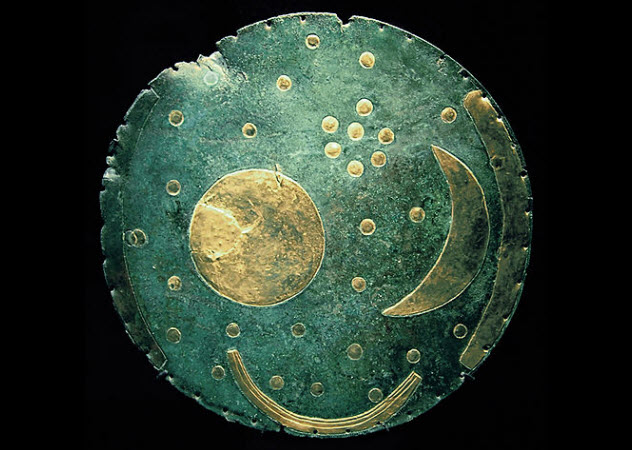
Named for the German town where it was discovered in 1999, the Nebra sky disk is the oldest depiction of the cosmos ever found. It had been buried alongside a chisel, two axes, two swords, and two arm rings.
Although this Bronze Age burial site dates to about 3,600 years ago, researchers acknowledge that the artifacts may be even older. Clearly depicting the Sun, the Moon, and some stars, the exact meaning of the disk has been open to interpretation. It’s generally thought to show the Sun and the Moon in the center, a half-circle strip beneath those bodies that may be a holy symbol, and smaller circles that represent the stars in constellations such as Orion, Andromeda, and Cassiopeia.
The Sun was seen as the giver of life because we can’t live without it. The Moon represented the passage of time. Usually, anyone who understood the cycles of the Moon enjoyed a certain status.
We don’t know who made the disk. But its layout of the stars suggests that the creators were located at the same latitude as Nebra, Germany. The metal in the piece was also traced to mines somewhere in Europe.
The two men who uncovered the artifacts in the burial site had no license to dig there. Although any finds of this sort automatically go to the government, the men sold the entire treasure trove on the black market. It wasn’t until 2002 that an archaeologist was able to set up a meeting to purchase the items, paying less than their estimated black market value of $590,000. Ultimately, the men who initially found the disk were arrested, and the artifacts were sent to the Museum of Halle.
5 Chankillo Astronomical Complex
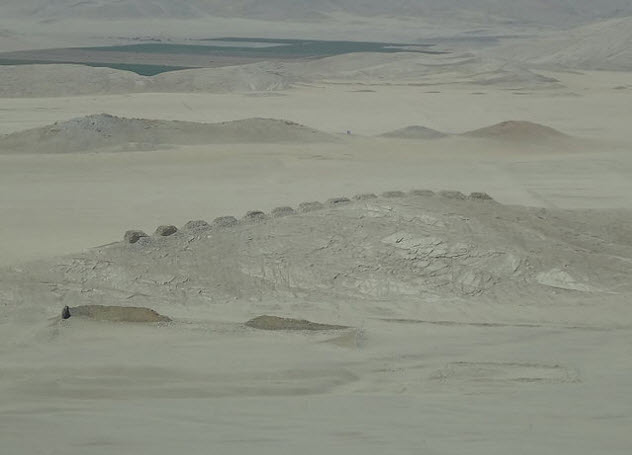
The Chankillo astronomical site in Peru is so complex that we only discovered its true function in 2007 with the help of a computer program designed to align solar panels. Stretching 300 meters (980 ft) along the hilltop, the site is made up of 13 towers arranged in a straight line.
As a fort, it was an incredibly poor choice of location, without defensive benefits, access to running water, or a food source. When archaeologists realized that one of the towers lined up with the sunrise on the summer solstice and another with the sunrise on the winter solstice, they began to suspect its true purpose.
Built about 2,300 years ago, the towers are the oldest solar observatory in the Americas. There are also separate viewing positions to the east and west of the towers that let someone see where the Sun is rising or setting along the complex. Even though the Sun’s path has shifted a fraction of a degree since the observatory was in use, this calendar can still determine the day of the year within a two-day margin of error.
Sadly, the massive solar calendar of Chankillo is the only trace of its builders’ civilization. Although it appears that they passed their astronomical knowledge to the Inca, we know nothing else about this South American culture that predated the Inca by more than 1,000 years. A similar site, attributed to the Inca, has been found near Lake Titicaca and has helped archaeologists trace the evolution of centuries of Sun worship.
4 The Hyginus Star Atlas
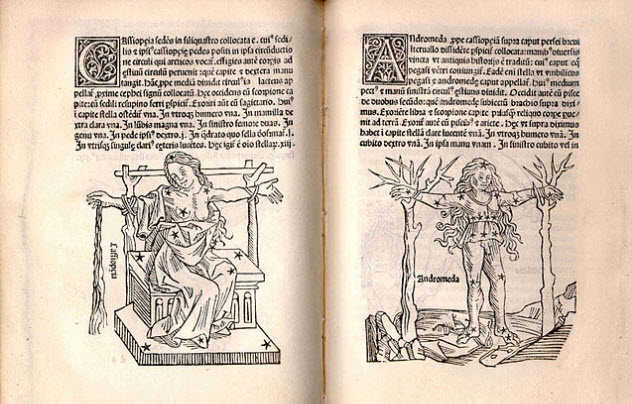
Also known as the Poetica Astronomica, Hyginus’s star atlas was one of the first depictions of the constellations. Although its authorship is debated, it is sometimes attributed to Gaius Julius Hyginus, who wrote between 64 BC and 17 AD. Others claim that the work has similarities to another piece by Ptolemy, suggesting that a different Hyginus wrote the text more than a century later.
Either way, when the Poetica Astronomica was reprinted in 1482, it became the first printed work to feature the constellations as well as the lore and mythology behind them. While other atlases gave more concrete mathematical information that could be used for navigation, the Poetica Astronomica was a more fanciful, literary interpretation of the stars and their stories. Woodcuts showed how many stars were in each constellation, with an overlay that supposedly illustrated the positions of those stars.
But most of the illustrations were reversed from reality, making the atlas useless for actually finding the constellations in the real world. However, the book was an invaluable resource for creating more practical star atlases and for preserving the mythology of the constellations.
3 The Celestial Globe
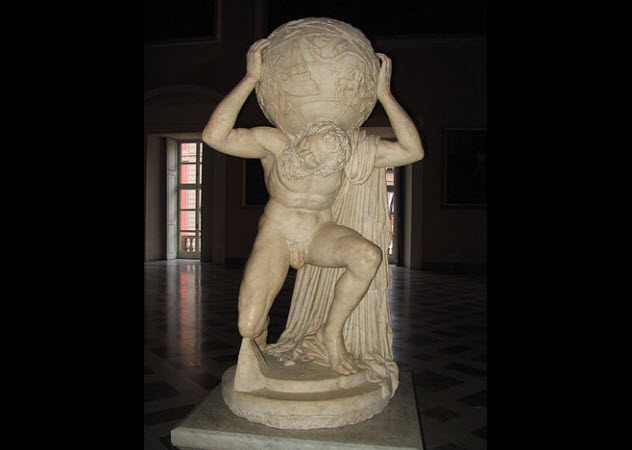
The celestial globe dates to a time when astronomers believed that the stars were on a globe of their own that circled the Earth. As that imagined globe moved, the stars moved, too. The celestial globes that were created to map that heavenly orb are absolutely stunning.
Some of the earliest globes were made by the ancient Greeks, and the idea remained a popular one well into the 16th century. The first printed globe in a form similar to our traditional globes was created by the German scholar Johannes Schoner. He offered his works of art as a pair—a celestial globe and a terrestrial one. There are only two known Schoner celestial globes still in existence. They’re beautifully crafted works of art, depicting the constellations as they would have looked in the night sky around the world.
The oldest example of a celestial globe dates to around 370 BC. You’ve probably seen it without realizing what it is. The Farnese Atlas, the famous marble statue from 73 BC of Atlas with the world on his shoulders, is actually holding this accurate celestial globe. The more astronomers learned about the stars, the more the globe changed, and the more detail it had. But the Farnese Atlas shows the stars as they would have been in the night sky over 2,000 years ago. However, like the Poetica Astronomica, there’s a problem with these globes. Designed to be viewed from the outside, the constellations are reversed from the way we’d really see them.
2 Armillary Sphere
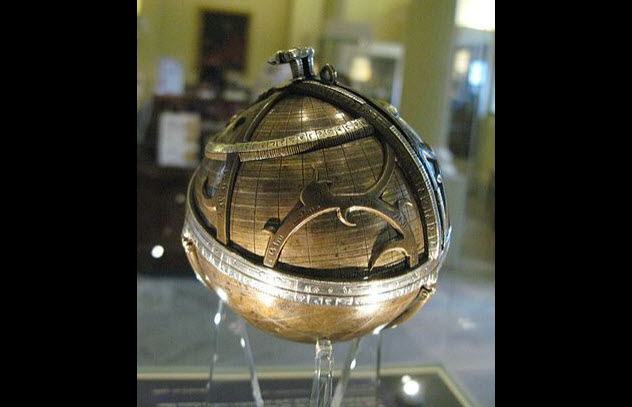
With its rings circling a central point, the armillary sphere was a distant relation to the celestial globe. There were two different types of spheres—observational and demonstrational. Ptolemy was one of the first people to use one. The rings were divided to allow the reader to turn them as well as to establish latitude and longitude.
Along with astrolabes, armillary spheres were used for navigation for centuries. Strangely, these common instruments were also deeply shrouded in mystery. Although it may have been a joint effort between the Greek and Islamic worlds, we’re not sure who invented the armillary sphere or how the demonstrational models were used. With the armillary sphere’s similarity to the celestial globe, many texts that refer to early astronomical instruments can be interpreted as talking about either one. The rings of an armillary sphere were usually rather delicate, so we don’t have many surviving examples.
The Whipple Museum in England has one that’s believed to be from the 1500s, and the Museum of the History of Science at Oxford has one from 1588. Perhaps the most intriguing use of the armillary sphere occurred when Portugal created their kingdom of Brazil. Portugal gave Brazil both a flag and an emblem that featured armillary spheres. Although Brazil replaced their flag when the country became independent, echoes of the ancient astronomical device are still evident in the starry blue globe on their flag.
1 El Caracol
Chichen Itza
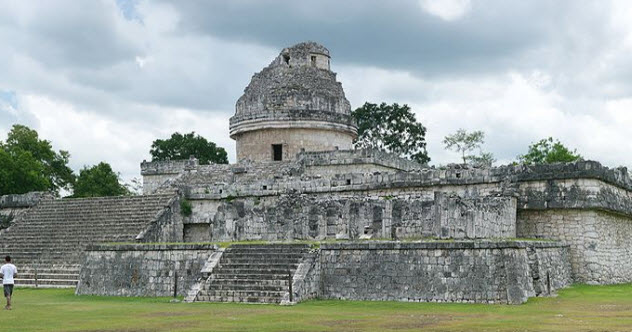
Chichen Itza was settled sometime between 415 AD and 455 AD. Its strangely shaped observatory is something of an oddity. While most astronomical instruments were attuned to the movement of the stars or the worship of the Sun, El Caracol (“the snail”) was focused on the movements of Venus.
The planet’s pattern of appearance and disappearance caused problems for astronomers for a long time. For the Maya, Venus was sacred. Everything, from festivals to sacrifices, was scheduled around the movement of the planet. Wars were even planned to start at the same time that Venus rose in the sky. The planet was a sign of good fortune, with coronations held as Venus made its appearance. Even games were scheduled according to Venus.
El Caracol was built in part as a temple to the god Quetzalcoatl and in part to track the movements of the mysterious planet Venus. Platforms and windows were constructed in positions specific to the movement of Venus, thought to tie into the worship of Quetzalcoatl and the changing of the seasons. Even the massive staircase that leads to the observatory was built with Venus in mind, as the staircase traces the planet’s northernmost position.
Written records from Spanish missionaries told of the importance of Venus and the Sun. But as many of those records have long been lost, researchers are still trying to determine the significance of El Caracol and many similar towers that have been found throughout the Mayan territories.








